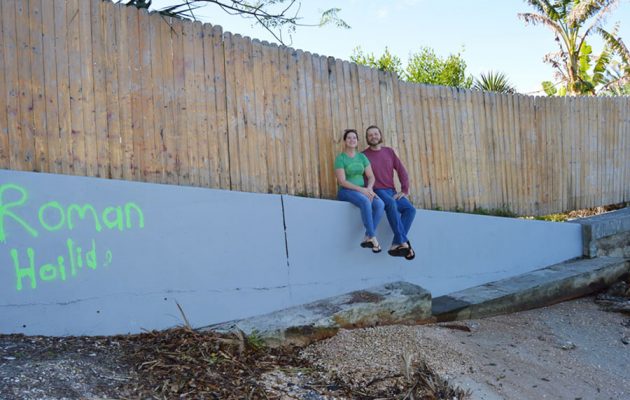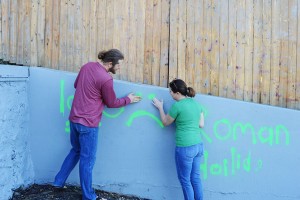With can-do attitude, Inwood residents clean up graffiti on city right-of-way

When it comes down to handling the rampant graffiti and trash situation on the city’s right-of-way at the end of their street, several Inwood Terrace residents have adopted the attitude, ‘If you want to get something done, do it yourself.’
In a meeting with District 5 Councilwoman Lori Boyer Jan. 22, some Inwood Terrace residents asked to transform the right-of-way into a public park as a solution to the trash, graffiti and teen partying problems that plague the small river access.
In the meeting, Boyer rejected the idea, siting the hefty expense of making the right-of-way Americans with Disabilities accessible, as well as the fact there is no bathroom and no space for parking at the end of the street.
In the meeting, Boyer suggested a street-level fence be erected in front of the stairs leading to the river. Her plan entailed giving a resident a key and charging them with opening the right-of-way in the morning and closing it at night. In a telephone interview, she said the cost of installing a fence would be in the vicinity of $6,500.
However, after the meeting, several Inwood Terrace residents said they don’t want a fence and decided to take matters into their own hands.
 “We don’t want a fence. There is not enough access to the river as it is,” said Jason Judge, an Inwood Terrace resident. “Fences are bad ideas. They try to keep us out and keep Mother Nature in. We like that people come and use it.”
“We don’t want a fence. There is not enough access to the river as it is,” said Jason Judge, an Inwood Terrace resident. “Fences are bad ideas. They try to keep us out and keep Mother Nature in. We like that people come and use it.”
Judge’s wife, Kelly Dyess, agreed. “We want it to be used, just respected and protected.”
To handle the graffiti problem, Judge, who was not present at the meeting, said he conducted some old-fashioned detective work using one of the phone numbers tagged in the graffiti to discover a few of the teens involved. He went door-to-door and ultimately was able to speak to the teen’s parents, who required their kids to pay for paint supplies and a pressure-washer rental.
“I didn’t do it for the recognition. I did it so that when my neighbors walk their children down there they won’t see anything rude,” Judge said. “We discovered some 14- and 15-year-old kids had vandalized it. As a former juvenile delinquent myself, I just followed their art work. These people are not vandals, they are kids. They’re not bad kids. They have too much time on their hands and not enough art skills. They always assume it’s a spot to paint graffiti and now they have been told otherwise. They weren’t the only ones, but they were the only ones that got caught. Actually, the kids volunteered to do the painting.”
The kids joined several residents on the street for a neighborhood clean-up party, Judge said, adding that he and his wife bought a new trash can for the right-of-way in the hopes it might encourage visitors to pick up their trash. If not, he and Dyess intend to pick it up themselves, he said.
Judge said the experience has had a silver lining. “I got to know the neighbors. There are some good people living in this neighborhood,” he said.
In an effort to deter future vandalism, Daryl Gottlieb, who also lives on Inwood Terrace, said he purchased two 20-LED motion-sensitive solar lights and has mounted them in the area. “They serve as an additional deterrent, not only to would-be vandals, but also to the local teenagers who think this is a convenient and inconspicuous place to do what teenagers do,” he wrote to Boyer in an email.
In addition to lighting, Inwood Terrace resident Joseph Lentz posted a custom-made sign at the entrance to the right-of-way near the stairs stating that the area is under 24-hour surveillance, Judge said, adding that he and his neighbors have spoken about “banding together” to buy a video camera to keep an eye on the area. They also intend to speak with Norma Hagan, a neighbor who lives adjacent to the river access, about planting vines and climbing plants on the public access side of her wooden fence. “This would not only add to the natural aesthetic quality of the area, but also serves as a deterrent, as it would eliminate a good swath of the ‘canvas,’” Gottlieb wrote in his email.
“A few on our street are determined to be hyper-vigilant about calling the non-emergency police number and/or requesting kids leave if we see that they’re up to no good,” wrote Gottlieb. “I know of two occasions this week where neighbors have either called the police or confronted kids who they saw drinking at the end of the street.”
Since the clean-up effort, several cars have been broken into on Inwood Terrace and the bulkhead and stairs down by the river were defaced again with graffiti. In regards to the cars, Judge said he put out an urgent alert on the website NextDoor, a neighborhood watch site. In answer to the new graffiti, Judge referred to his handy paint can.
“I plan to keep on painting it,” said Judge, noting in one area the vandals used temporary hair dye, which is easy to wash off. “I think for teenage kids it was just the fact that it was pure. Somebody wanted to make it un-pure.”
 One way to keep the bulkhead free from graffiti might be to have a mural artist paint on it, said Judge, adding that a clear coat of anti-graffiti coating could be applied afterward so any further writing could be easily washed off.
One way to keep the bulkhead free from graffiti might be to have a mural artist paint on it, said Judge, adding that a clear coat of anti-graffiti coating could be applied afterward so any further writing could be easily washed off.
“We live here. This is our street. We can do it ourselves,” said Judge. “We can’t wait for Lori Boyer and the city all day. If we all acted at the root of the problem, we could probably get these things taken care of okay.”
In his email to Boyer, Gottlieb suggested local artists might love the opportunity to paint a mural on the gray walls lining the beach. He suggested Boyer contact Tony Allegretti, Executive Director of the Cultural Council of Greater Jacksonville who oversees the Art in Public Places Program to inquire if there is any funding available for a local art project and to find out the process of soliciting bids from artists. He also asked her to look into the possibility of installing a video camera at the end of the street to catch license plates.
“Please do not proceed with the construction of the fence until and unless all the other measures have proven to be failures,” Gottlieb pleaded in his email, noting that he believes a fence “would be the most obstructive and damaging to the unique quality of the area.”
In a telephone interview, Boyer said she appreciates the effort the residents have gone to solve the problem. She also noted in order to install things on public property a permit is required. She said she forwarded Gottlieb’s information to the city Public Works Department and hoped that permits might be able to be obtained retroactively.
By Marcia Hodgson
Resident Community News




 (5 votes, average: 4.20 out of 5)
(5 votes, average: 4.20 out of 5)

